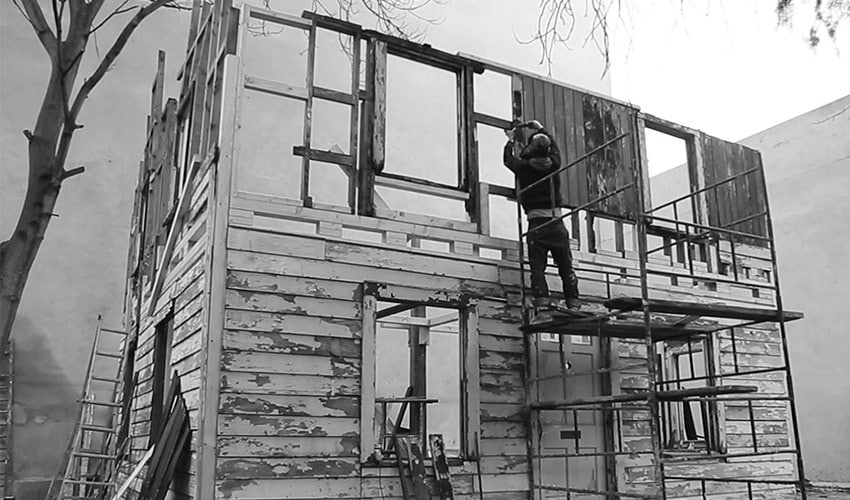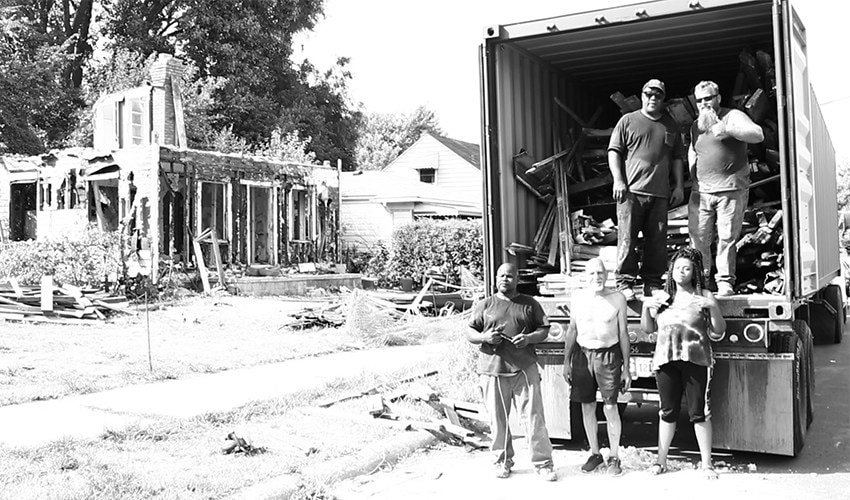
Is Moving Rosa Parks’ House To Berlin A Step In The Right Direction? It’s Complicated… (Part 2)
In some fairly unsettling news, Rosa Parks’ House is now in Berlin. The American artist Ryan Mendoza moved the house, in which the civil rights icon lived after she fled the hostilities of the South, from Detroit to his backyard in Berlin-Wedding and will open the doors to visitors during Gallery Weekend. The White House Documentary, a film by Fabia Mendoza, Ryan’s wife, tells how the project came about and will be screened at the artist’s studio.
Rhea McCauley, Rosa Parks’ niece, asked Ryan Mendoza to save the house from being demolished by taking it to Europe after no American institution expressed interest in preserving it – something he had previously done with another blighted house in Detroit. We talked to the Berlin-based American artists Isaiah Lopaz and Jessica Lauren Elizabeth Taylor (part 1) about the White Saviour complex in the art world and what the project means for Rosa Parks’ legacy.
Interview with Isaiah Lopaz
What were your thoughts when you heard that Rosa Parks’ house, the house where an American civil rights icon lived, was shipped to Berlin as an art project because the city of Detroit was going to demolish it?
Isaiah: My first thoughts were “Why is it being shipped here, of all places?” If it has to be dismantled because it was due to being demolished, why isn’t it somewhere in the United States, who is the artist that’s working on this project and what is his connection to Black people and to the civil rights movement?
How do you feel about the fact that Berlin is presented as this utopian place of freedom and the statements that were made about how Germany has dealt with its dark past?
Isaiah: When someone asserts that Germany has dealt with its past and we’re specifically speaking about Rosa Parks and we’re specifically speaking about the civil rights movement we are talking about anti Black racism. What is Germany’s connection with anti Black racism and is this something that is discussed? Is this something that Germany has dealt with? Because if we are not talking about Germany’s relationship to anti Black racism, to colonialism, to one of the first genocides of the 20th century, the genocide of the Herero and Nama people, then it doesn’t make sense to bring up a past that doesn’t reference these things.
Germany in my opinion is not dealing well with its colonial past, many white Germans don’t even seem to be aware that Germany had colonies. They are not aware of the Berlin conference taking place here, they are not aware of the great scramble for Africa. In Berlin we still have streets that pay homage to German colonialism. I’m not saying that America has dealt with its past, it obviously hasn’t. When we talk about Berlin there is this idea of yeah it’s multicultural and people seem to celebrate that but when you speak with POC about their experiences here then all that glitters isn’t gold.

What do we learn about Rosa Parks and the civil rights movement by viewing an abandoned house that’s disassociated from its context, here in Berlin?
Isaiah: I think we learn nothing about Rosa Parks. The only thing that I know is that Ryan Mendoza said that if he didn’t save this house it would have been destroyed – but I don’t understand why it’s in his backyard, closed off. I find it difficult to believe that nobody wanted to preserve her house. I feel like he’s mining her name for his own fame and critical acclaim. And that’s the only appearance that she makes in this work.
How can you as a white artist have her house in your backyard and talk about preserving history but you’re not in any way connecting with Black organisations, with Black cultural institutions? Has he contacted the ISD?* Has he contacted the Black Lives Matter movement here? If you are a white artist and you are going to preserve something like this, if you are going to undertake something like this, you have to do it with a sense of responsibility and you have to have awareness of your place and your position and the best thing that you can do is to step aside and let people of colour or in this case let Black people be responsible for this. And that’s not what he’s doing.
What’s the solution? Should white artists stop focusing on race issues?
Isaiah: I don’t think that white artists should stop focusing on race issues. I think that white artists have a responsibility to speak about race but they have a responsibility to speak about it in a way that is honest, in a way that is aware of where they are coming from and how they are contextualised. As a Black artist I have always chosen to speak about race – but people have also always expected me to speak about race. So if a white artist wants to take on race as a subject they have a responsibility to do it in a manner that is highly aware of what race is, how it functions and how they benefit from race simply by being white. I have to be aware of these things. I can’t just think of myself as coming from a neutral place or being outside of history.
Is there any way that a white man wouldn’t have been criticised for getting involved?
Isaiah: Yes, I think there are many ways of doing this without being criticised. One way would have simply been to buy the house and put it in storage until he can find an institution or an artist willing to take on this project.
Do you think people would have cared as much if a Black artist decided to bring the house to Berlin?
Isaiah: I think if a Black artist had saved Rosa Parks’ house I can expect two things: I can either expect that nobody would really care about her house being preserved or that Black people would care about her house being preserved. I don’t think that white people in Germany care about Rosa Parks’ house being preserved. In fact one of the founders of the BLM movement here was at the opening of the house and she said that instead of talking about Rosa Parks, people were talking about contemporary art and other art exhibitions they were going to.
Has the house also turned into another piece of contemporary art?
Isaiah: I have trouble calling it a piece of art because it’s all surface and no substance. There’s nothing that engages a contemporary dialogue about activism or about race. Rosa Parks was a black woman who was advocating for the rights of black people and who was willing to be in prison for that and to spend the rest of her life looking over her shoulder, so when you bring her house here and you don’t talk about history, the present, or the fact that black people and other non white people are still fighting for basic human rights, you miss the mark. You have the name but you don’t have the story. You have the house but you don’t have the foundation.
Isaiah Lopaz is an American artist and author who lives and works in Berlin. In his blog Him Noir, he seeks to create an open dialogue about race, politics and culture.
In his series of workshops titled Things You Can Tell Just By Looking At Us he aims to have an unapologetic, multidimensional conversation about anti-Black racism. The next event of this series is on May 6th 2017 at Berlin’s Kunsthalle am Hamburger Platz.
Click here to read part 1 with Jessica Lauren Elizabeth Taylor.
*Tahir Della of the ISD commented that his organisation very much appreciated Ryan Mendoza’s preservation of the house of the civil rights icon Rosa Parks. However, since the artist hasn’t reached out to Black organisations in Germany yet, he questioned if there would be a political discourse on racism in Germany.
“The White House Documentary” will be screened at Studio Mendoza on Friday, 28 April and on Saturday, 29 April from 4-10pm. Rosa Parks’ House can be visited during the same times.
On 29 April artists from Detroit and Berlin will pay tribute to Miss Rosa Parks at an open mic session. The Mendozas are planning to organise a number of events at the house that are dedicated to Rosa Parks and her legacy.
This article originally appeared in i-D Germany. Click here to read the German version.
Get DADDY in your Inbox
Stay in the loop by subscribing to our newsletter
